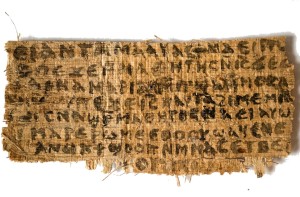It now turns out (surprise! surprise!) that the document—gleefully dubbed The Gospel of Jesus’ Wife—is a forgery … and not a particularly good one at that.
But, actually, even if the so called “gospel” had been genuine, it would have shed no new light on the genuine Gospel of Jesus Christ—no matter what Professor King and her supporters claim.
The fraudulent “gospel” originated in Egypt—it was written in Coptic, the Egyptian language at the time, not in New Testament Greek—and Egypt, from the 2nd century onwards was a notorious source of bizarre Gnostic fabricated accounts of the doings of Jesus and his disciples.
Thus the place where the document purportedly originated should alone have been enough to alert Professor King to tread carefully. Indeed, as she is an expert on “Coptic literature, Gnosticism and women in the Bible,” it is somewhat surprising she was taken in by a relatively crude forgery.
However Professor King and her supporters postulated the document was a translation of an earlier one that was written in Greek. Yet there was no good reason to believe that the origin of this document was any different from that of the many other Gnostic writings that have been unearthed in Egypt over the centuries.
Indeed, a huge cache of such writings was found at Nag Hamadi in Egypt just after World War II. These writings, all originating centuries after the Apostolic era, were widely published in the 1950s.
Some decades later they were “resurrected” by feminist theologians in their efforts to support feminist religious theories.
Gnosticism flourished in Egypt long after it had ceased to be a major thorn in the flesh of Christian orthodoxy elsewhere. But then Egypt had a multi-millennia history of mystery cults.
Indeed, it had a long tradition of blatantly inventing gods out of whole cloth—for example Serapes, introduced by the Ptolemys [Cleopatra’s forbears] in order to embrace and synthesize both ancient Egyptian and Greek religious traditions.
Small wonder that early Egyptian Copts—raised on a diet of mystery religion —felt free to play fast and loose with a Christianity they found just a tad too straightforward for their tastes.
Professor King seems to be mining the Nag Hamadi cache or one much like it. She unveiled a similarly strange find—dubbed the Gospel of Judas [Iscariot]—amid much ballyhoo a year or so back. She has also published on another fictitious Gnostic work entitled The Gospel of Mary of Magdala.
As with the Gospel of Judas, publish or perish academia, aided and abetted by an overwhelmingly anti-Christian big media, have worked feverishly to portray the “wife gospel” as possibly shedding light on “a controversial aspect” of Jesus’ life.
When Professor King presented her research on the “wife gospel” in Rome early last month at the International Congress of Coptic Studies, she declared: “Christian tradition has long held that Jesus was not married, even though no reliable historical evidence exists to support that claim.”
“This new gospel doesn’t prove that Jesus was married, but it tells us that the whole question only came up as part of vociferous debates about sexuality and marriage.
“From the very beginning, Christians disagreed about whether it was better not to marry, but it was over a century after Jesus’s death before they began appealing to Jesus’ marital status to support their positions.”
Jesus’ marital status has long been a focus of feminist and other “cutting edge” theologians in order to discredit the four canonical Gospels and establish their own radically revised orthodoxy.
It is hard not to view the unveiling of the “wife gospel” in Rome as cocking a revisionist snook at the Roman Catholic Church which require its priests to be celibate.
The agenda was spelled out by Michael D’Antonio, who blogs about the Roman Church for the leftist Huffington Post.
“Beyond internal Catholic Church politics, a married Jesus invites a reconsideration of orthodox teachings about gender and sex,” he said.
“If Jesus had a wife, then there is nothing extra Christian about male privilege, nothing spiritually dangerous about the sexuality of women, and no reason for anyone to deny himself or herself a sexual identity.”
However, news that the “wife gospel” is a demonstrable fake has left Professor King and her revisionist allies with egg on their faces.
The forgery was detected by number of highly qualified scriptural scholars, including Christian Askeland, a Coptic specialist at Indiana Wesleyan University.
According to Mr. Askeland the “wife gospel” is a match for a papyrus fragment of text from St. John’s Gospel that had been copied from a 1924 publication and is, thus, clearly a forgery.
What’s more, Mr. Askeland found the images of the forged St. John’s fragment among the on-line links that Harvard used in its publicity material about “wife gospel.” This St. John’s fragment, it turned out, shared many similarities with the “wife gospel”, including handwriting, ink, writing instrument, and even a repeated typographical error.
Two factors, according to Mr. Askeland, demonstrate beyond question “The Wife Gospel” to be a forgery. First, it shares the same line breaks as the 1924 text. Second, the fragment is written in a peculiar dialect of Coptic called Lycopolitan, which fell out of use during or before the Sixth Century.
Moreover, radiometric texts commissioned by Professor King concluded the papyrus plants upon which “The Wife Gospel” is written had been harvested between the Seventh and Ninth Centuries. Thus, the papyrus could not have been in existence at the time it was purportedly written.
The unmasking of the bogus document has received nowhere near the amount of publicity that attended its unveiling. One of the very few news outlets that recorded the event was The Wall Street Journal.
The deafening silence that greeted the revelation that the document is bogus, however, reveals a very great deal about the knee-jerk anti-Christian bias that animates a large swathe of the American news media, as well as the lamentable state of what passes for mainline Biblical scholarship. GPH✠



